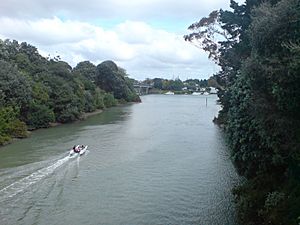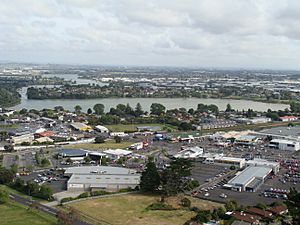Panmure Basin facts for kids

The Panmure Basin, also called the Panmure Lagoon, is a unique body of water in Auckland, New Zealand. It's like a lake that connects to the sea, and it sits inside an old volcano! This special type of volcanic crater is known as a maar. You can find it just south of the Panmure town centre.
Contents
Panmure Basin: A Volcanic Wonder
The Panmure Basin is part of the Auckland volcanic field, an area with many ancient volcanoes. What makes Panmure Basin special is how it was formed. It's an explosion crater, created when hot magma (melted rock) from deep underground met cold groundwater. This caused a huge explosion, blasting out a large hole in the ground.
Discovering a Hidden Volcano
In February 2008, scientists were drilling into the mud at Panmure Basin. They made an exciting discovery: a buried scoria cone! A scoria cone is a small, cone-shaped hill made of volcanic rock fragments. It's like a mini-volcano that forms during an eruption.
Some people thought this meant a brand new volcano was found. However, geologists (scientists who study rocks and the Earth) explained something different. They believe this scoria cone was actually part of the *same* eruption that created the Panmure Basin crater.
How the Volcano Formed
Imagine the eruption happening in two stages:
- Wet Stage: First, the hot magma hit groundwater. This caused a massive, explosive eruption, creating the big crater we see today.
- Dry Stage: After the water was used up, the eruption continued in a "dry" phase. This was like a fire-fountain, where lava shot into the air and cooled into small pieces. These pieces piled up to form the scoria cone.
So, the Panmure Basin is similar to other volcanoes in Auckland, like the Auckland Domain Volcano or Mangere Lagoon Volcano. Many of these also have scoria cones inside their craters. The only difference is that Panmure Basin's scoria cone was small and got completely buried under mud over time.
How Old is Panmure Basin?
Scientists are still working to figure out the exact age of the Panmure Basin eruption. One way to date volcanic events is using radiocarbon dating. This method looks at how much carbon-14 is left in old organic materials.
However, a radiocarbon date from Panmure Basin seems to have come from a much older fossil forest. This forest was buried directly under the volcanic ash. So, the age of the eruption is still a bit of a mystery!


